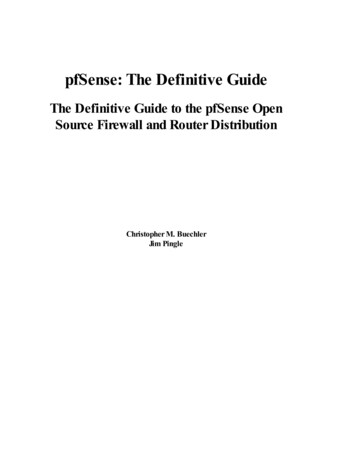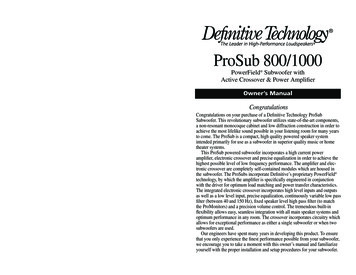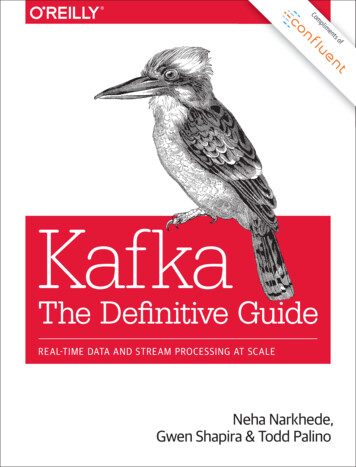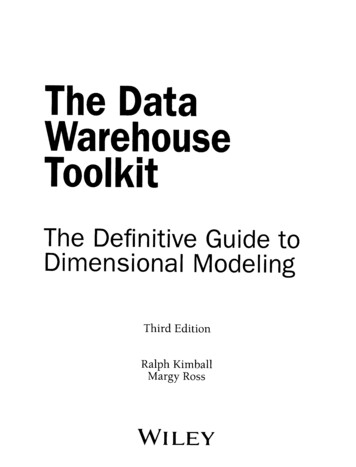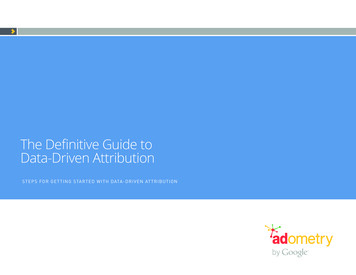
Transcription
The Definitive Guide toData-Driven AttributionSTEPS FOR GETTING STARTED WITH DATA-DRIVEN ATTRIBUTION
CONTENTSContentsIntroduction 3What is Attribution? 5T H E DEFI NI TIVE GUID E TO DATA - DR IV E N ATTR IB U T I O NWould We Benefit from Data-Driven Attribution?7How Does Data-Driven Attribution Fit into My Analytics Toolset?9What Questions Does Data-Driven Attribution Answer?14Five Steps to Your Data-Driven Attribution StrategyStep 1: Define GoalsStep 2: Justify BudgetStep 3: Be SelectiveStep 4: Get PreparedStep 5: Evaluate Success171922273438Conclusion41Glossary432
IntroductionTHE DEFINITIV E GUIDE TO DATA-DRIVEN ATTRIBUTION
INTRODUCTION5x5x54%Top-performing marketingorganizations are five times morelikely to use advanced attribution.54%20-30%By contrast, 54% ofmarketer still creditthe last-click, 50%25-50%Source:The State of Marketing 2013, IBM’s Global Surveyof Marketers. Global Summit 2013, n.d. Web.T H E DEFI NI TIVE GUID E TO DATA - DR IV E N ATTR IB U T I O N5x54%5xIntroduction5x5x54%Data-driven attribution helps marketers know more and guess less. If your organization is still focused on crediting onlythe last touch point for your marketing success, you may be leaving up to 20%-40% of potential ROI improvement onthe table.Data-driven attribution offers an unprecedented level of visibility into the customer journey, enabling marketers to makefact-based decisions, gain efficiencies and realize greater returns on marketing investments.54%20-30%20-30%In this guide, you will find an extensive introduction to data-driven attribution so that you can better understand howand if a solution can help you move your marketing forward. In addition to understanding the questions that attributioncan help your organization answer, you will learn if it is a fit for your business. Lastly, you will be left with tips and tricksfor how to move forward with a data-driven attribution program.20-30%54%10-20%Opportunities for crease in effective displayand retargeting CPA.Decrease in level of effort topull, aggregate, and distributecross-channel se in optimizationwithin channels including PPC,Affiliate, Email, and Social.Increase in performanceacross channels.Increase in overall marketinginvestment performance.4
What is Attribution?THE DEFINITIV E GUIDE TO DATA-DRIVEN ATTRIBUTIONSummaryAssumptions about how your marketing activities impact yourcustomers lead to a misinformed marketing strategy. Data-drivenattribution reveals the real path-to-purchase, allowing you to finetune strategies based on real customer behavior.
WHAT IS ATTRIBUTION?RULES BASED MODELSWhat Is Attribution?Attribution is the practice of tracking and valuing allmarketing touch points that lead to a desired outcome.Data-driven attribution employs a powerful combinationof predictive algorithms and integrated analytics toreveal — and properly credit — every bit of marketingspend that contributes to conversion.1FIRST TOUCHTHE MODEL MATTERSNot all attribution models are created equal. Simple or“rules-based” methodologies assign credit according to apre-defined formula.1. Single-Touch: Assigns 100% credit to one touchpoint — usually the first or last touch.123LAST TOUCH2. Even: Assigns equal credit to all touch points on thepath — if 4 exist, each gets 25%.While simple attribution models offer general answersacross a basic marketing mix, today’s cross-channelmarketers may want a more scientific approach to drivethe results they need.RULES WERE MADE TO BE BROKENBecause credit is dictated from the top-down, rulesbased attribution models obscure the real value of eachtouch point. By contrast, data-driven attribution modelsdetermine the importance of each touch point as dataaccumulates “from the bottom-up.”In this case, sophisticated algorithms to determine whichtouch points are the most influential. By comparing eachconversion path, factors such as the number of touchpoints in the sequence, the order of exposure and thecreative assets used are all factored into results.3. Custom: Assigns arbitrary credit to each touchpoint — the first is the “introducer,” the last is the“closer” and intervening points are “promoters.”Introducers and closers often get outsized credit,while promoters divide the rest without regard toorder of exposure or creative assets used.EVENCUSTOMT H E DEFI NI TIVE GUID E TO DATA - DR IV E N ATTR IB U T I O NNext Up: Having defined data-driven attribution, the next question is whetheryour organization is ready to embrace this data-intensive practice. Looking at yourorganizational and data maturity can yield the answer.6
Would We Benefit fromData-Driven Attribution?THE DEFINITIV E GUIDE TO DATA-DRIVEN ATTRIBUTIONSummaryLook at your marketing mix and resulting data to determine yourorganization’s readiness for data-driven attribution. Some solutionsrequire volumes of high quality data — and an organizationalappetite to operationalize attribution insights.
WOULD WE BENEFIT FROM DATA-DRIVEN ATTRIBUTION?Would We Benefit fromData-Driven Attribution?HIGH QUALITYFocusedDataData-driven attribution is an intensive data-modeling exercise in which complex algorithms find and analyze statisticallyrelevant patterns across volumes of quality data. Not all organizations have the level of data maturity required to benefitfrom a stand-alone enterprise level data-driven attribution solution.SystematicDataLOW VOLUMEHIGH VOLUMELowDataChaoticDataLOW QUALITYLOW DATA MATURITYFull cross-channel data-driven attribution may not bea fit for organizations that have lower levels of datamaturity due to having little data or low data quality.Low Data. Organizations that do little measurablemarketing, leverage few channels and as a result,have little or no data are usually unable to use datadriven attribution.HIGH QUALITYHIGH DATA MATURITYData-driven attribution benefits organizations with highdata maturity with large data volumes and high dataquality across their channel mix.Focused Data. Organizations with ready access tohigh-volume, high-quality data are excellent data-drivenattribution candidates. Many “digital native” organizationsfocus all marketing efforts in digital channels, allowingrelatively easy access to data.Disorganized Data. On the other hand, marketers whopursue many channels with non-standardized goals andOrganized Data. Organizations with a complex onlineobjectives (generally in the form of mismatching KPIs)andDATAoffline marketing mix, that can access volumes ofFOCUSED DATASYSTEMATICmay struggle to derive actionable insights.high-quality data across all channels and that have theORFOCUSEDMARKETERPro TipIf your complex marketing mix includes both onlineand offline channels, your data-driven attributionsolution must be able to handle a wide variety ofdata sources and volumes, including the abilityto integrate with next-generation marketing mixmodeling for a more holistic view.ORpeople and processes needed to access data and takeSYSTEMATICaction, are the best candidates for data-driven ribution, chances are youNext Up:LOWIf yourorganization is ready CHAOTICfor data-drivenhave a wide rangeOR of analytics tools to measureOR and manage the customer lifecycle.Gaining support for data-driven attribution means understanding where it fits withinSIMPLEDISORGANIZEDthat toolset. Let’s take a look.MARKETERT H E DEFI NI TIVE GUID E TO DATA - DR IV E N ATTR IB U T I O NMARKETERLOW QUALITY8
How Does Data-driven AttributionFit Into My Analytics Toolset?THE DEFINITIV E GUIDE TO DATA-DRIVEN ATTRIBUTIONSummaryTo build momentum towards a new attribution strategy, ensurethat all key stakeholders understand the purpose and limitations ofall analytics tools — and how data-driven attribution can unify andcomplete marketing performance measurement.
HOW DOES DATA-DRIVEN ATTRIBUTION FIT INTO MY ANALY TICS TOOLSET?The Analytics ToolsetVE72RID1 Marketing mix modelingPLANMESSAGINGTARGET12 Real-Time Bidding (RTB) and3Demand-Side Platforms (DSP)3 Ad servers and searchmanagement systems4 Website AnalyticsREACHCONSUMERDATA-DRIVENATTRIBUTIONBUY5 Customer RelationshipAdvertising AgencyT H E DEFI NI TIVE GUID E TO DATA - DR IV E N ATTR IB U T I O N5MIZ4PTITPlatforms (DMPS)APE7 Data Management6REManagement (CCCM)ENGAGE WITHBRANDO6 Cross-Channel CampaignEManagement (CRM)10
HOW DOES DATA-DRIVEN ATTRIBUTION FIT INTO MY ANALY TICS TOOLSET?How Does Data-drivenAttribution Fit into MyAnalytics Toolset?You can sit in a lawn chair to watch the big game on yourTV — but isn’t your recliner better suited to the task?While a number of measurement tools help you assessand track the customer lifecycle, it is important to use theright tool for each job and to recognize the limits of each.Data-driven attribution creates a “single source oftruth” about marketing performance that unifies andcompletes your analytics toolset. While other toolsprovide specific insights, data-driven attribution providesan overall view of marketing performance. Let’s explorethe marketing analytics landscape and where attributionfits into the mix.ResourceLearn more about incorporating marketingmix modeling with data-driven attribution inAdometry’s article about “The Evolution ofMarketing Mix Modeling”.1. MARKETING MIX MODELING (MMM):You’ve run your campaign and it’s time to re-assessthe big picture. Do you need MMM or data-drivenattribution? The answer is both. Attribution allows youto understand your marketing down to the user-level,accurately measuring the impact of each touch pointsand tactic. MMM on the other hand helps you lookacross all your marketing influences at an aggregatelevel, including factors like competition and comparingagainst your “business as usual”. To create the bestpossible plan, make sure data-driven attribution insightsare used to inform MMM activities.Bottom Line: MMM helps you plan and optimize at thehighest levels while Attribution shows how to improve moregranularly. For the best marketing intelligence, use nextgeneration MMM and data-driven attribution in concert.T H E DEFI NI TIVE GUID E TO DATA - DR IV E N ATTR IB U T I O N2. REAL-TIME BIDDING (RTB)AND DEMAND-SIDE PLATFORMS (DSP)How will your campaign reach highly targeted audiencesacross a variety of publishers? Programmatic buyingplatforms may be the answer. Based on conversiondata, RTBs and DSPs constantly improve placementtargeting. Keep in mind that since their revenues are tiedto placement volumes, RTBs and DSPs have a vestedinterest in high attribution credit for their placements.Because they only measure the media they place, theyend up over-crediting themselves for all conversions.They do not have the ability to assess the full path-topurchase, nor can they accurately assess attributioncredit for the media they place.Bottom Line: RTBs and DSPs have limited visibility andcannot assess credit in an unbiased or fractional way.Data-driven attribution can provide insights that realtime bidding partners can use to buy top performing adplacements.3. AD SERVERS AND SEARCHMANAGEMENT SYSTEMSEnsuring that your ads are managed and servedaccording to your media buy is the domain of ad serversand search management systems. These tools not onlyshow you when and where an ad was shown, they alsomeasure the basic performance of each asset. As such,an ad server can reveal which ads are performing best— but only regarding portions of your campaign thatfall within the channel it manages. As they attempt todistribute credit for all conversions to this single channel,they can cause double-counting.11
HOW DOES DATA-DRIVEN ATTRIBUTION FIT INTO MY ANALY TICS TOOLSET?Bottom Line: While ad servers and search managementsystems allow spot-checking within a channel, their focusis too narrow to offer data-driven attribution.4. WEBSITE ANALYTICSSite Analytics is a critical tool for improving yourwebsite and mobile apps. The measurement, collection,analysis and reporting of on-site activities allow youto understand user needs and fine-tune your siteto meet those needs. Website analytics typicallyprovide only a “last-touch” or rules-based view ofcampaign performance as they measure only the clicksimmediately prior to a website visit. Upper-funnel touchpoints (such as display and social) are going to be highlydisadvantaged when held to this analysis.Bottom Line: Website analytics are a complement, nota replacement, for data-driven attribution, which offers amore comprehensive view of what brought users to yourwebsite.5. CUSTOMER RELATIONSHIPMANAGEMENT (CRM)As customers roll in, your CRM is there to capturetransaction, contact and segment data, and that’s a goodthing. But, CRMs are primarily focused on customerservice and support, not marketing. Though CRMs cantrack multiple channels, they look mainly at lower-funnelactivities, offering limited visibility into acquisition andcross-channel marketing in “non-direct” channels such associal, display or affiliate.6. CROSS-CHANNEL CAMPAIGNMANAGEMENT (CCCM)CCCM systems are similar to CRMs, but with a greaterfocus on marketing than on customer service. Thesemarketing databases contain contact information —names, addresses, emails and SMS data — for bothcustomer and prospects. This aids you in determiningwhich audiences to target and where to find them. WhileCCCMs may help with selection and execution, they areunable to tell you how that audience responded, offeringlittle or no performance analytics.Bottom Line: CCCM data is a valuable input for datadriven attribution. Once attributed performance isknown, these insights can be fed back to your CCCM foreven better selection.7. DATA MANAGEMENT PLATFORMS (DMPS)DMPs are unified technology platforms that intakedisparate first, second, and third-party data sets, providenormalization and segmentation on the data, and allowmarketers to push the resulting segmentation intolive interactive channel environments. While DMPs areexcellent data collection tools that can provide inputto data-driven attribution solutions, they do not inthemselves provide insights or recommendations tomarketers regarding optimal channel mix.Bottom Line: Data-driven attribution solutionscomplement DMPs. DMPs collect valuable segment data,allowing attribution solutions to provide a deeper level ofactionable insights.Bottom Line: CRM data is an input that can feed yourdata-driven attribution solution to yield a more completepicture of customer behavior.T H E DEFI NI TIVE GUID E TO DATA - DR IV E N ATTR IB U T I O N12
HOW DOES DATA-DRIVEN ATTRIBUTION FIT INTO MY ANALY TICS TOOLSET?ADVERTISING AGENCIESLet’s suppose you start with developing a creativecampaign and detailed targeting recommendationsdesigned to catch the eye of your audience — in additionto all these tools. A good ad agency is an invaluableasset, from recommending strategy, to creativedevelopment, and on to tactical execution. Keep inmind that an agency’s viewpoint is often limited to thechannels they manage, and includes a vested interestin justifying their own value. While most agencies dooffer analytics — and some are even building in-houseattribution capabilities — they often lack the data,machine learning and mathematical expertise to tacklein-depth analysis.Bottom Line: Augment your agency’s understandingwith third-party, data-driven attribution insights youprovide to inform, guide and inspire agency teams.Next Up: To propel the organizational conversation about data-driven attribution,let’s take a closer look at the questions that marketing performance managementplatforms can answer.T H E DEFI NI TIVE GUID E TO DATA - DR IV E N ATTR IB U T I O N13
What Questions Does Data-DrivenAttribution Answer?THE DEFINITIV E GUIDE TO DATA-DRIVEN ATTRIBUTIONSummaryGet ready to guess less and know more. Data-driven attributionoffers a range of unique benefits both within and across channels,including the insights you need to make fact-based budget planningand investment decisions.
WHAT QUESTIONS DOES DATA-DRIVEN ATTRIBUTION ANSWER?What Questions Does Datadriven Attribution Answer?BudgetPlanningWondering how to set your display budget? Ifyou learn that display offers a 30% lift to searchconversion rates, it makes sense to increase yourdisplay budget. It could also inform an overallmarketing budget increase — increasing displaywill generate more search traffic and give you moreoverall reach.BudgetPlanningOptimizationOptimizationTo improve your in-flight campaign, do you investmore in that top performing ad? If you’re saturatedwith a publisher, it may be the the wrong move.Data-driven attribution reveals the value of eachincremental dollar, so you can make fact-baseddecisions. As a result you, you may decide to allocateadditional budget to email or search instead.T H E DEFI NI TIVE GUID E TO DATA - DR IV E N ATTR IB U T I O NData-driven attribution offers a clear, comprehensiveview of the customer journey. This clarity allows youto both build better campaigns and optimize thosethat are in-flight. Before implementing a solution, it isimportant to both understand — and set stakeholderexpectations around — the three main benefits of datadriven attribution.Data-driven attribution allows you to look back, forwardand act on-the-fly to improve marketing performance.Marketers that leverage a full data-driven attributionsolution can measure benefits within and acrosschannels in these key areas of return.INTRA-CHANNEL BENEFITS Brand Safety. Ensure that ads are not served onnegative websites or next to inappropriate or branddamaging content.1 Intra-Channel Performance. See exactly whichelements of your marketing programs are workingwithin each channel — to a high degree of granularity— so you can identify top-performers and takeadvantage of the best opportunities. Viewability. Ensure that impressions are actuallyviewed and not served off the viewable area ofthe page.2 Cross-Channel Performance. Get clarity acrossall channels, so you can compare performance andcorrect both over and under-spending. Breakingdown silos allows your organization to unifyaccountability and plan holistically to drive morestrategic marketing success. Frequency Capping. Ensure that the optimal dailyfrequency caps are in place and operating properly.3 Efficiency and Cohesion. Replace time-consumingdata comparison and report pulling with easy-tounderstand dashboards. This means that teamsacross your organization can move faster and makebetter decisions based on a cohesive set of actionableinsights. The best solutions can even push out realtime insights to ensure cohesion with external partnersworking on your behalf. Monitoring. Ensure that geotargeting, pacing andother campaign goals are being met. Geo and Time of Day. Ensure that audiencesare targeted geographically and at the right timeof day with the appropriate message based ontheir responses. Creative Messaging and Placement. Identify bestand worst performing ads to ensure that the bestcreative, messaging, sequencing, targeting andplacements are in the media plan. Overlap Reduction. Ensure that overlaps betweensites — that do not increase conversion — arereduced to eliminate wasted ad spend and guardagainst overexposure.15
WHAT QUESTIONS DOES DATA-DRIVEN ATTRIBUTION ANSWER?CROSS-CHANNEL BENEFITS Budget Planning. Data-driven attribution insightsallow you to have a clear understanding of thecontribution that each channel has on your end goal,which can aid you in finding the optimal budget. Optimization. Non-linear modeling allows you totweak and improve the performance of in-flightcampaigns in a more holistic and accurate way. Impact Analysis. Lift and funnel stage reports provideyou with a view into how each channel is impactingother channel’s performance to give you a fullunderstanding of the true value of each channel. Campaign Strategy. Evaluating creative andplacements across all channels will show you whichtactics within your campaigns are working and whichneed to be tweaked so that you can reach consumerswith a consistent message.EFFICIENCY AND COHESION BENEFITS Unified Metrics. By evaluating all channels through asingle system, you will start measuring all channels by acommon set of metrics that are based on the businessrather than by the individual channel which cuts downon the time spent “translating” metrics across channelsfor one view of performance. Unified Reporting. Similarly, by utilizing one systemfor all reporting and metrics, it will cut down on thetime required to pull reporting from multiple systemsand minimize confusion across the organization as towhat actual results look like. Flexible Reporting. Data-driven attributionplatforms generally allow you to view reporting in anumber of different ways as well as export resultsinto your internal business intelligence tools so youdon’t have to scrutinize a “one-size fits all” reportbut can instead spend the time improving yourcampaigns based on findings. Ecosystem Integrations. Programmatic connectorsinto the marketing ecosystem allow you to havefractional attribution metrics pushed directly to RTBpartners for automatic optimization, cutting down onthe time you have to manually pass reporting backand forth.Now that we’ve explored the definition, uses andbenefits of how attribution fits into the space today,we’re going to walk you through how you go aboutselecting an attribution solution.Next Up: Now that you’ve made your stakeholders aware of the purpose andbenefits of data-driven attribution, it’s time to get serious about selecting the rightsolution for your organization. Let’s look at the 5-step selection process that will helpdrive success with data-driven attribution.T H E DEFI NI TIVE GUID E TO DATA - DR IV E N ATTR IB U T I O N16
Five Steps to Your Data-DrivenAttribution StrategyTHE DEFINITIV E GUIDE TO DATA-DRIVEN ATTRIBUTIONSummaryData-driven attribution offers a strategic viewpoint. Ensure that yourbusiness goals are defined to connect marketing metrics back tovaluable business outcomes so that data-driven attribution will helpyou drive business success.
FIVE STEPS TO YOUR DATA-DRIVEN ATT RIBUTION STRATEGYFive Steps to Your Data-Driven Attribution StrategyAs with any emerging discipline, data-driven attribution solutions differ widely. To get the benefits of data-drivenattribution for your organization, you must ask the right questions, solidify the right budgets and motivate the rightresources. Here are five key steps you can take, right now.“We like to help our clients1get away from channel-onlythinking. Bragging rights in theform of “my channel gets morethan 50% credit” doesn’t helpincrease sales in a vacuum.2The metrics must connectback to business goals.”1Define Goals2Justify Budget33Be Selective44Get Prepared55Evaluate Success- Paul Pellman, Head of Adometry, GoogleT H E DEFI NI TIVE GUID E TO DATA - DR IV E N ATTR IB U T I O N18
FIVE STEPS TO YOUR DATA-DRIVEN ATT RIBUTION STRATEGYStep 1Define Goals1Define Goals2233Be Selective44Get PreparedJustify BudgetTHE DEFINITIV E GUIDE TO DATA-DRIVEN ATTRIBUTION
FIVE STEPS TO YOUR DATA-DRIVEN ATT RIBUTION STRATEGYStep 1: Define GoalsIn order to choose the right measurement andanalytics tools for your business, consider your currentpain points and business goals. It isn’t enough to findout how much ”credit” each channel deserves — youmust determine how attributed credit drives value forthe business.ExampleIs your goal to get more “likes” or to get more sales?While Facebook likes may be a goal for your socialcampaigns, the ultimate goal for your clothingbrand is to sell jeans. Avoid “soft” goals and focus onfinding a solution that allows you to see the lift socialprovides to sales — regardless of likes.Begin by determining the value all your marketingactivities must deliver for the business and prepareto take a holistic view of data-driven changes you willmake to meet those goals. Once you do, you will beable to determine marketing’s impact on revenue, andtherefore, formulate budgets that will yield high returnfor the business.Here are some of the questions you should answerinternally before beginning any data-driven attributionselection process.Pro TipAdopting data-driven attribution strategies canmean overhauling your internal measurementmechanisms. Do not undertake this task withoutclarifying and gaining consensus on businessobjectives.T H E DEFI NI TIVE GUID E TO DATA - DR IV E N ATTR IB U T I O NWHAT ARE YOUR OBJECTIVES AND MEASUREMENTGOALS? DO THEY ALIGN ACROSS YOUR BUSINESS?Data-driven attribution requires a common, unifiedsuccess metric, and knowledge of your long-term goals.Define objectives and KPIs that align across channelsand departments. Attribution doesn’t work overnightand it won’t work if various business units or channelsmeasure success differently.WHAT ARE YOUR TACTICAL CONVERSION EVENTS?Your attribution solution will credit touch points alongthe way to your defined conversion events. If you aredoing any website optimization, you have probablyalready thought about how to guide consumers tospecific actions on your site. Whether a sale, a contentdownload or a lead form submission, determine whatdigital conversions you will “attribute” towards. Ensurethat these conversion events are agreed upon acrossyour organization and are the main goal across theentire business (not just for a specific channel).WHAT DOES MARKETING SUCCESS LOOK LIKE?Now, let’s take your success events one step furtherin order to understand what marketing will attemptto accomplish for your company as a whole. If you areaccountable to help increase sales, is there a way to tierevenue or margin to your website or digital elements?Often, goals are not just about revenue — but they mustbe something actionable.Don’t succumb to “shiny new object syndrome” bypurchasing a solution just because of the buzz. Instead,carefully examine the questions you’d like to answer,clearly define success metrics based on facts andensure that your goals are in line with vendor abilities.20
FIVE STEPS TO YOUR DATA-DRIVEN ATT RIBUTION STRATEGYPro TipIdentify a strong program owner who can set andmanage stakeholder expectations throughout theprocess, and who will be able to resolve roadblocksto drive organizational success.Ready, Set, Go!Once you’ve laid out your goals, you are ready to startyour data-driven attribution selection process. Onthe road to a great solution, you will need to recruitcross-company involvement. Don’t overwhelm yourteam or other resources all at once. Taking on morethan your organization can handle could sabotageyour chance at success.Alternatively, avoid the “we’re not there yet,” mentality.Change isn’t easy, but you will never be ready if youdon’t take the plunge. The results are well worth theeffort but you have to take a leap!“The optimizations we wereable to make paid off thesolution within a quarter.”Drew McKenzie, Senior Manager,Digital Media at LuxotticaT H E DEFI NI TIVE GUID E TO DATA - DR IV E N ATTR IB U T I O NWith all of this in mind, think about what you’d like yourtimeline to look like. Knowing that it will take time towalk before you run, pick a provider that will act as along-term partner, and that shows potential for growthin the future.Bottom Line: Data-driven attribution offers a strategicviewpoint to your marketing campaigns. Ensure that yourbusiness goals are defined to connect marketing metricsback to valuable business outcomes so that data-drivenattribution will help you drive business success.21
FIVE STEPS TO YOUR DATA-DRIVEN ATT RIBUTION STRATEGY11Define GoalsStep 2Justify Budget2Justify Budget33Be Selective44Get Prepared55Evaluate SuccessTHE DEFINITIV E GUIDE TO DATA-DRIVEN ATTRIBUTION
FIVE STEPS TO YOUR DATA-DRIVEN ATT RIBUTION STRATEGYStep 2: Justify BudgetThe Current SpendAttribution requires thinking outside the silo — and thatmeans finding the dollars to pay for the analytics thatbreak down those silos. Before engaging a provider,set yourself up for success by earmarking a crossdepartmental budget.In this simple example, we’ll assume Display, Search,Email and Affiliate are the primary digital marketingchannels, with the following monthly spend, revenuesand conversions.Since the analytics portions of your budget may alreadybe allocated, guide the conversation by promoting thebenefits of data-driven attribution to key stakeholders.The right solution will pay for itself by creating crossdepartment efficiencies and increasing the return oneach marketing investment.Bottom Line: To determine your budget threshold fordata-driven attribution, consider its overall value to thebusiness. Then, consider real-world returns of 5% - 15%.A Real-WorldBudgeting ExerciseSetting expectations around the potential resultsof data-driven attribution is critical. Account for anyexpense of your attribution program (whether externalor internal) with realistic analysis for your organization inorder to gain support for cross-departmental budgeting.Channels and Current SpendAllocation Per MonthCHANNELSPENDDisplay Impressions 375,000Search Clicks 325,000Emails Delivered 75,000Affiliate 225,000Online Spend 1MMCurrent Digital Returnon Ad Spend (ROAS) 2.50Current Online MonthlyConversions345,366Current AnnualConversions4.14MMCurrent eCPA 2.90Current Yearly Revenue 30MMTotal Yearly Spend 12MMLet’s walk through a budgeting exercise that typifiesreturns you can expect with data-driven attribution.Though no two businesses are alike, and there isno way to predict actual results, this outline — fromcurrent cross-channel marketing budget distributionto quantified results — offers realistic proportions. Thefollowing low, average and high yields can help youestimate your expected returns.T H E DEFI NI TIVE GUID E TO DATA - DR IV E N ATTR IB U T I O N23
FIVE STEPS TO YOUR DATA-DRIVEN ATT RIBUTION
from a stand-alone enterprise level data-driven attribution solution. LOW DATA MATURITY Full cross-channel data-driven attribution may not be a fit for organizations that have lower levels of data maturity due to having little data or low data quality. Low Data. Organizations that do little measurable marketing, leverage few channels and as a .


